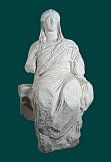Demeter of Knidos

Demeter was one of the most admired Greek goddesses. In 1857/58 a marble statue of a seated figure was excavated. Unfortunately, it was badly damaged. The arms, which had been made separately, her legs, the front legs of the throne, the backs and the suspected armrests are missing. Nevertheless, Demeter of Knidos became one of the most important sculptures of the 4th century BC. Careful consideration of the sculpture reveals two trends: one one hand, the massive forms and their compactness, suggest calm, which has been described as the dignity of a matron. On the other hand, there are suggestions of motion in her look that fades into the distance, her head and the fact that the knees are at different heights. So the statue suggests both calm and motion, which have come to be thought of as characteristic of Demeter. She searches restlessly for Persephone (= Kore), her daughter, and when she realises that she has been taken to the underworld by Hades, she withdraws completely. Only when Persephone had been brought back from the underworld and it has been arranged that she will henceforth spend a third of the year there and the remaining two thirds on Mount Olympus, does Demeter return to her work of growing the seed. Christians, e. g. Augustin, rejected - from their perspective of Almighty God and his creation - the notion of a cyclical creator connected with Demeter. It was decided to admit the piece featuring Demeter to a collection for Christian Archeology and Ecclesiastical Art because it provokes discussion about different non-Christian concepts.




